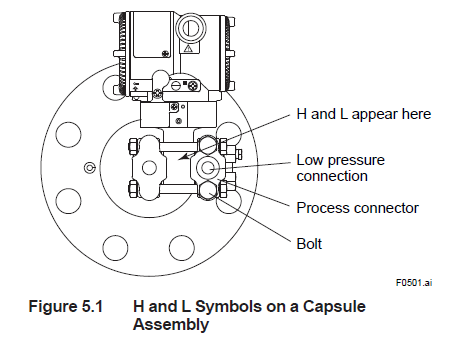Low-side Impulse Piping
Before connecting the transmitter to the process, study the transmitter installation location, the process piping layout, and the characteristics of the process fluid and make appropriate changes and additions to the connection configurations.
1. Connecting the Impulse Piping to the Transmitter:
A. Check the High and Low-Pressure Connections on the Transmitter - The letters H and L on the capsule assembly indicate the high and low-pressure sides. For liquid level measurement in an open tank, the low-pressure side measures atmospheric pressure. (For a closed tank, connect the impulse line to the low-pressure side of the transmitter to measure the pressure in the tank.)
B. Tighten the Process Connector Mounting Bolts - After connecting the impulse line, tighten the process connector mounting bolts.
C. Remove the Impulse Piping Connecting Port Dustproof Cap - The impulse piping connecting port of the transmitter is covered with a plastic cap to keep out dust.
This cap must be removed before connecting the line. (Be careful not to damage the threads when removing this cap. Never insert a screwdriver or other tool between the cap and port threads to remove the cap.)
2. Routing the Impulse Piping
A. Impulse Piping Slope - The impulse piping must be routed with only an upward or downward slope. Even for horizontal routing, the impulse piping should have a slope of at least 1/10 to prevent condensate (or gases) from accumulating in the pipes.
B. Preventing Freezing - If there is any risk that the process fluid in the impulse piping or transmitter could freeze, use a steam jacket or heater to maintain the temperature of the fluid.
After completing the connections, close the valves on the process pressure taps (main valves), the valves at the transmitter (stop valves), and the impulse piping drain valves, so that condensate, sediment, dust, and other extraneous material cannot enter the impulse piping.
The impulse piping connects the process outputs to the transmitter. In order to convey the process pressure accurately, select the proper piping method for the process fluid.
